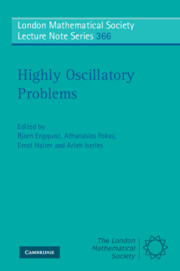Book contents
- Frontmatter
- Contents
- Preface
- 1 Oscillations over long times in numerical Hamiltonian systems
- 2 Highly oscillatory quadrature
- 3 Rapid function approximation by modified Fourier series
- 4 Approximation of high frequency wave propagation problems
- 5 Wavelet-based numerical homogenization
- 6 Plane wave methods for approximating the time harmonic wave equation
- 7 Boundary integral methods in high frequency scattering
- 8 Novel analytical and numerical methods for elliptic boundary value problems
8 - Novel analytical and numerical methods for elliptic boundary value problems
Published online by Cambridge University Press: 07 September 2011
- Frontmatter
- Contents
- Preface
- 1 Oscillations over long times in numerical Hamiltonian systems
- 2 Highly oscillatory quadrature
- 3 Rapid function approximation by modified Fourier series
- 4 Approximation of high frequency wave propagation problems
- 5 Wavelet-based numerical homogenization
- 6 Plane wave methods for approximating the time harmonic wave equation
- 7 Boundary integral methods in high frequency scattering
- 8 Novel analytical and numerical methods for elliptic boundary value problems
Summary
Abstract
A new method for solving boundary value problems has recently been introduced by the first author. Although this method was first developed for non-linear integrable PDEs (using the crucial notion of a Lax pair), it has also given rise to new analytical and numerical techniques for linear PDEs. Here we review the application of the new method to linear elliptic PDEs, using the modified Helmholtz equation as an illustrative example.
Introduction
Almost forty years ago an ingenious new method was discovered for the solution of the initial value problem of the Korteweg–de Vries (KdV) equation [GGKM67]. This new method, which was later called the inverse scattering transform (IST) method was based on the mysterious fact that the KdV equation is equivalent to two linear eigenvalue equations called a Lax pair (in honor of Peter Lax, [Lax68] who first understood that the IST method was the consequence of this remarkable property). The KdV equation belongs to a large class of nonlinear equations which are called integrable. Although there exist several types of integrable equations, which include PDEs, ODEs, singular-integrodifferential equations, difference equations and cellular automata, the existence of an associated Lax pair provides a common feature of all these equations.
After several attempts to extend the inverse scattering transform method from initial value problems to boundary value problems, a unified method for solving boundary value problems for linear and integrable nonlinear PDEs was introduced by the first author in [Fok97] and reviewed in [Fok08].
- Type
- Chapter
- Information
- Highly Oscillatory Problems , pp. 194 - 239Publisher: Cambridge University PressPrint publication year: 2009
- 6
- Cited by



